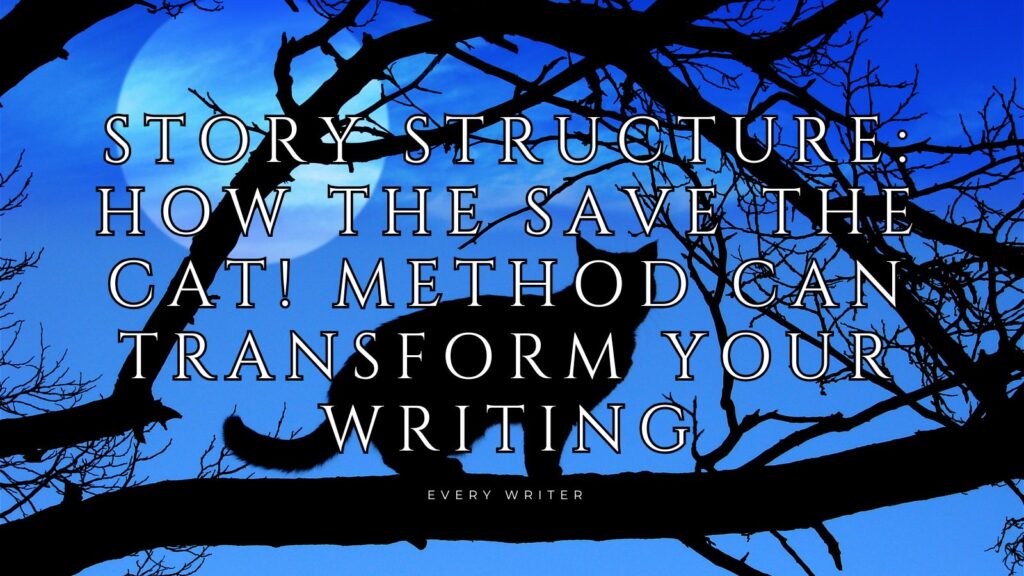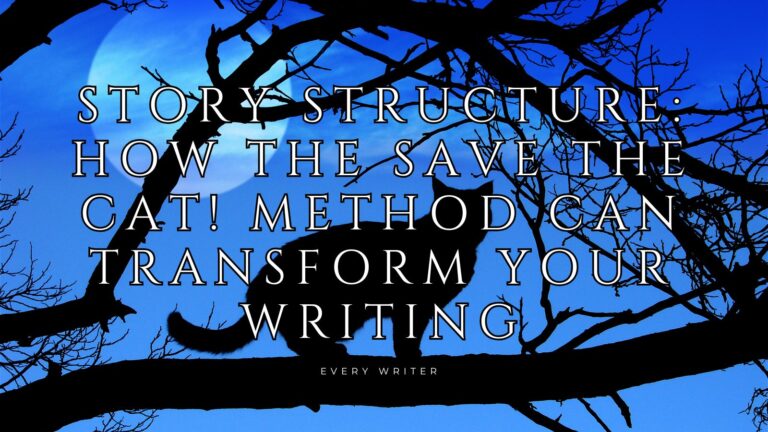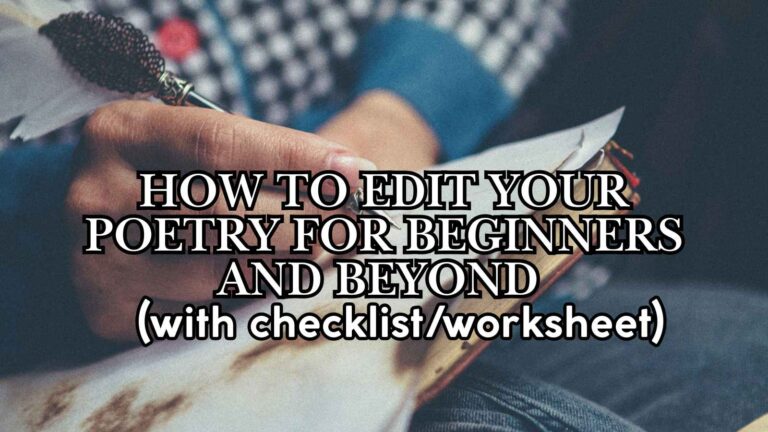Story Structure: How the Save the Cat! Method Can Transform Your Writing
Hello, wonderful writers!
Have you ever stared at a blank page, your brilliant story idea swimming in your head but refusing to take shape on the page? Or maybe you’ve written yourself into a corner at page 100, with no clear path forward? Perhaps you’ve completed a manuscript only to realize something feels fundamentally “off” about your story’s flow?
If you’ve nodded yes to any of these scenarios, I have fantastic news for you: there’s a roadmap that can guide you through the storytelling wilderness, and it’s called the Save the Cat! method.
Created by the late screenwriter Blake Snyder, this revolutionary story structure framework has helped countless writers transform vague concepts into compelling, well-structured narratives that captivate readers and audiences alike. What began as a guide for screenwriters has evolved into a universal storytelling language that novelists, memoirists, and writers of all stripes now swear by.
The magic of Save the Cat! lies in its blend of time-tested storytelling principles with practical, actionable steps that demystify the writing process. By breaking your story into 15 essential “beats,” this method ensures your narrative hits all the right emotional notes, maintains proper pacing, and delivers a satisfying character transformation that will resonate with your audience.
Today, I’m thrilled to share not just the principles behind this game-changing approach, but also a comprehensive worksheet that will become your new best friend in the writing process. Whether you’re drafting your first novel or your fifteenth screenplay, the Save the Cat! Beat Sheet is about to transform how you tell stories.
Ready to discover the structure that’s behind some of the most successful books and films of our time? Let’s dive in!
The History and Magic Behind Save the Cat!: A Story Revolution
Imagine it’s the early 2000s, and the screenwriting world is dominated by dense theoretical texts and vague artistic advice that leaves new writers scratching their heads. Enter Blake Snyder, a successful screenwriter who believed great storytelling shouldn’t be a mysterious art form but rather a learnable craft with concrete principles. In 2005, Snyder published “Save the Cat! The Last Book on Screenwriting You’ll Ever Need” – a title that proved remarkably prophetic for many writers.
But why “Save the Cat”? The name comes from Snyder’s belief that every protagonist needs a moment early in the story where they do something kind (like saving a cat) that makes the audience root for them. This simple yet profound insight exemplifies what made Snyder’s approach revolutionary: he cut through the complexity to reveal the emotional heart of storytelling.
What began as a fresh take on screenwriting quickly exploded into a global phenomenon. Before his untimely passing in 2009, Snyder expanded his work with “Save the Cat! Goes to the Movies” and “Save the Cat! Strikes Back.” His legacy continued to grow posthumously with adaptations for novelists, including Jessica Brody’s “Save the Cat! Writes a Novel,” which brought these transformative principles to fiction writers everywhere.
The benefits of the Save the Cat! method are nothing short of transformative. First, it provides a clear roadmap that eliminates the terror of the blank page – you’ll always know what comes next. Second, it ensures proper pacing, so your story never drags or rushes through important moments. Third, it guarantees emotional impact by building in key moments that connect with readers on a primal level. And perhaps most importantly, it creates a framework for character transformation, ensuring your protagonist undergoes a meaningful journey that will resonate with your audience.
Writers who initially resisted “formula” have become the method’s biggest champions after discovering that rather than limiting creativity, the Beat Sheet actually frees you to focus on what makes your story unique. The structure handles the heavy lifting of narrative architecture while you pour your creative energy into memorable characters, dialogue, and the special elements that only you can bring to the page.
From blockbuster screenplays to bestselling novels, from Hollywood to indie publishing, Save the Cat! has become the not-so-secret weapon of writers who understand that behind every “overnight success” is a rock-solid structure that keeps readers turning pages long into the night. And now, with our comprehensive worksheet, you’ll have this powerful tool right at your fingertips!
From Screen to Page: Why Save the Cat! Works for All Storytellers
One of the most remarkable aspects of the Save the Cat! method is its versatility across mediums. While Blake Snyder originally developed his beat sheet for screenwriters, the underlying principles have proven to be universal storytelling DNA that works brilliantly for novelists too. Let’s explore how this powerful structure adapts seamlessly between the silver screen and the printed page!
At its core, the Save the Cat! beat sheet recognizes something fundamental: whether we’re watching a two-hour film or savoring a 400-page novel, our brains are wired to respond to certain storytelling rhythms. The emotional journey, the transformation arc, the moments of tension and release—these elements transcend medium because they’re based on how humans have processed stories for thousands of years.
For screenwriters, the beat sheet provides precise timing guidelines—the Catalyst should hit around the 10% mark (roughly page 10 of a 110-page screenplay), the Midpoint exactly halfway through. Novelists might worry these rigid percentages wouldn’t translate to their work, but Jessica Brody’s adaptation proved otherwise. The same percentages work remarkably well when applied to total word count or page count, giving novelists the same structural guidance that screenwriters have enjoyed.
The difference lies not in the story beats themselves but in how they’re executed. Screenwriters must convey everything visually and through dialogue, often with just a few lines to establish what novelists might explore over several pages. A novelist can dive deep into a character’s internal debate after the Catalyst, while a screenwriter might need to externalize this through action or confrontation. Yet the emotional purpose of each beat—and its place in the overall structure—remains consistent.
Genre writers have discovered the beat sheet works brilliantly across categories too. Romance novelists use it to ensure the relationship develops at the right pace. Mystery writers find it perfect for timing their revelations and red herrings. Fantasy authors use it to pace their world-building alongside character development. The framework is rigid enough to provide guidance but flexible enough to accommodate the unique demands of any story type.
Many novelists who initially resisted “screenwriting techniques” now consider the beat sheet their secret weapon. Why? Because while novels certainly offer more room for digression, reflection, and exploration than films, readers still expect a satisfying emotional journey with properly timed turning points. The beat sheet ensures these crucial moments happen when readers subconsciously expect them, creating that unputdownable quality we all strive for.
The worksheet I’m sharing today is designed with this cross-medium versatility in mind. Whether you’re crafting the next great American novel or a screenplay you hope will catch Hollywood’s eye, these beats will guide you toward a story that resonates deeply with your audience. The language of story transcends medium—and Save the Cat! speaks that language fluently!
Success Stories: Writers Who Found Gold With Save the Cat!
The impact of the Save the Cat! method extends far beyond theoretical appeal—it has a proven track record of transforming struggling writers into successful storytellers across multiple mediums.
Consider Alyson Noël, author of the bestselling “Immortals” series, who credits the Save the Cat! beat sheet with helping her overcome structural challenges in her novels. After discovering the method, she was able to streamline her writing process and maintain the consistent output needed for her successful career. Her experience demonstrates how the beat sheet can help authors who need to balance creativity with productivity.
In screenwriting circles, John August (writer of “Big Fish” and “Charlie and the Chocolate Factory”) has spoken about how the Save the Cat! methodology provides a valuable framework without being overly prescriptive. While August doesn’t follow every beat religiously, he acknowledges the value of understanding these structural principles and often refers newer writers to Snyder’s work.
The influence of Save the Cat! can also be seen in the work of author Jessica Brody, who was so transformed by applying Snyder’s principles to her own fiction that she wrote “Save the Cat! Writes a Novel,” adapting the method specifically for novelists. Her young adult novels, including “The Chaos of Standing Still” and “A Week of Mondays,” showcase the beat sheet in action, with perfectly timed turning points and satisfying character arcs.
Perhaps most telling are the countless testimonials from previously unpublished writers who found their breakthrough after restructuring their manuscripts according to the beat sheet. Writers’ forums and workshops are filled with stories of authors who received rejection after rejection until they applied the Save the Cat! principles—then suddenly found agents and publishers responding positively to their work.
Film schools and MFA programs increasingly incorporate Snyder’s concepts into their curricula, recognizing that while artistic vision is essential, understanding structure gives students practical tools to execute that vision effectively. The method’s influence can be spotted in blockbuster films and critically acclaimed indies alike, proof of its flexibility across genres and styles.
What makes these success stories particularly compelling is how diverse they are—from thriller writers to romance novelists, from Hollywood screenwriters to indie filmmakers. The beat sheet doesn’t produce cookie-cutter stories; rather, it provides the reliable foundation that allows unique creative voices to shine through.
With our worksheet as your guide, you’ll be following in the footsteps of these successful storytellers, using time-tested principles to bring your unique vision to life on the page or screen.
Your Secret Weapon: The Save the Cat! Beat Worksheet
The journey from initial concept to polished manuscript can feel overwhelming, but having the right tools makes all the difference. That’s why I’m thrilled to share the Save the Cat! Beat Sheet Worksheet – your new creative companion that transforms abstract story principles into actionable steps.
Unlike generic writing templates, this worksheet is specifically engineered around Blake Snyder’s proven methodology. Each section guides you through the critical beats while prompting you with exactly the right questions to uncover your story’s strongest elements. The worksheet becomes your story’s foundation, ensuring you never lose sight of the emotional throughline that will captivate your audience.
What makes this worksheet particularly powerful is its dual focus on structure and character. As you fill in each beat, you’re simultaneously building your plot architecture and your protagonist’s transformation journey. The “Six Things That Need Fixing” section alone has helped countless writers develop deeper, more nuanced character arcs that feel authentic and earned.
The worksheet’s visual layout reinforces the percentage guidelines that give Save the Cat! stories their perfect pacing. For novelists, these percentages easily translate to word count divisions; for screenwriters, they map directly to page numbers. Having these guideposts visible as you plan ensures your story never sags in the middle or rushes through crucial moments.
Perhaps most valuably, this worksheet serves as a diagnostic tool when you hit roadblocks. Struggling with your second act? Return to your Fun and Games section. Character feeling flat? Review your All Is Lost moment. The worksheet becomes a map you can reference whenever you feel lost in your own narrative.
Professional writers often keep their completed beat sheets posted near their writing spaces, referring back to them throughout the drafting process. Many report that this simple practice cuts their revision time dramatically by preventing structural problems before they occur.
Whether you’re plotting your first novel or your tenth screenplay, this worksheet adapts to your needs, providing just enough structure to clarify your thinking without constraining your creativity. Download it, print it, fill it out – and watch as your story transforms from vague concept to compelling narrative ready to capture hearts and minds.
Conclusion: Your Story’s New Beginning
The Save the Cat! method has transformed the way writers approach storytelling across mediums, providing clarity where there was confusion and confidence where there was doubt. Through its origins with Blake Snyder, its adaptation for novelists, and its proven success stories, this methodology has earned its place in the toolkit of serious storytellers everywhere.
The Beat Sheet Worksheet I’ve shared today isn’t just another template—it’s your partner in the creative process, guiding you through each crucial turning point toward a story that works. In a craft filled with subjective advice and vague principles, this worksheet offers tangible, actionable steps that yield measurable results.
Remember that structure isn’t the enemy of creativity—it’s the canvas upon which your unique vision can fully express itself. By mastering these fundamental beats, you free your creative mind to focus on the elements that make your story special: your voice, your characters, your world, your themes.
So download the worksheet, grab your favorite pen, and begin mapping the journey of your protagonist. Whether you’re crafting the next bestselling novel or an award-winning screenplay, you now have the roadmap successful writers have used to capture the hearts of audiences worldwide.
Your story matters. Give it the structure it deserves.
Happy writing!
DOWNLOAD YOUR WORKSHEET HERE. And leave us a comment telling us if this helped your writing!
- Story Structure: How the Save the Cat! Method Can Transform Your Writing - April 23, 2025
- HALFWAY TO HALLOWEEN: 50 Words of Horror Contest - April 22, 2025
- How to Edit your poetry for beginners and beyond (with worksheet) - April 18, 2025





